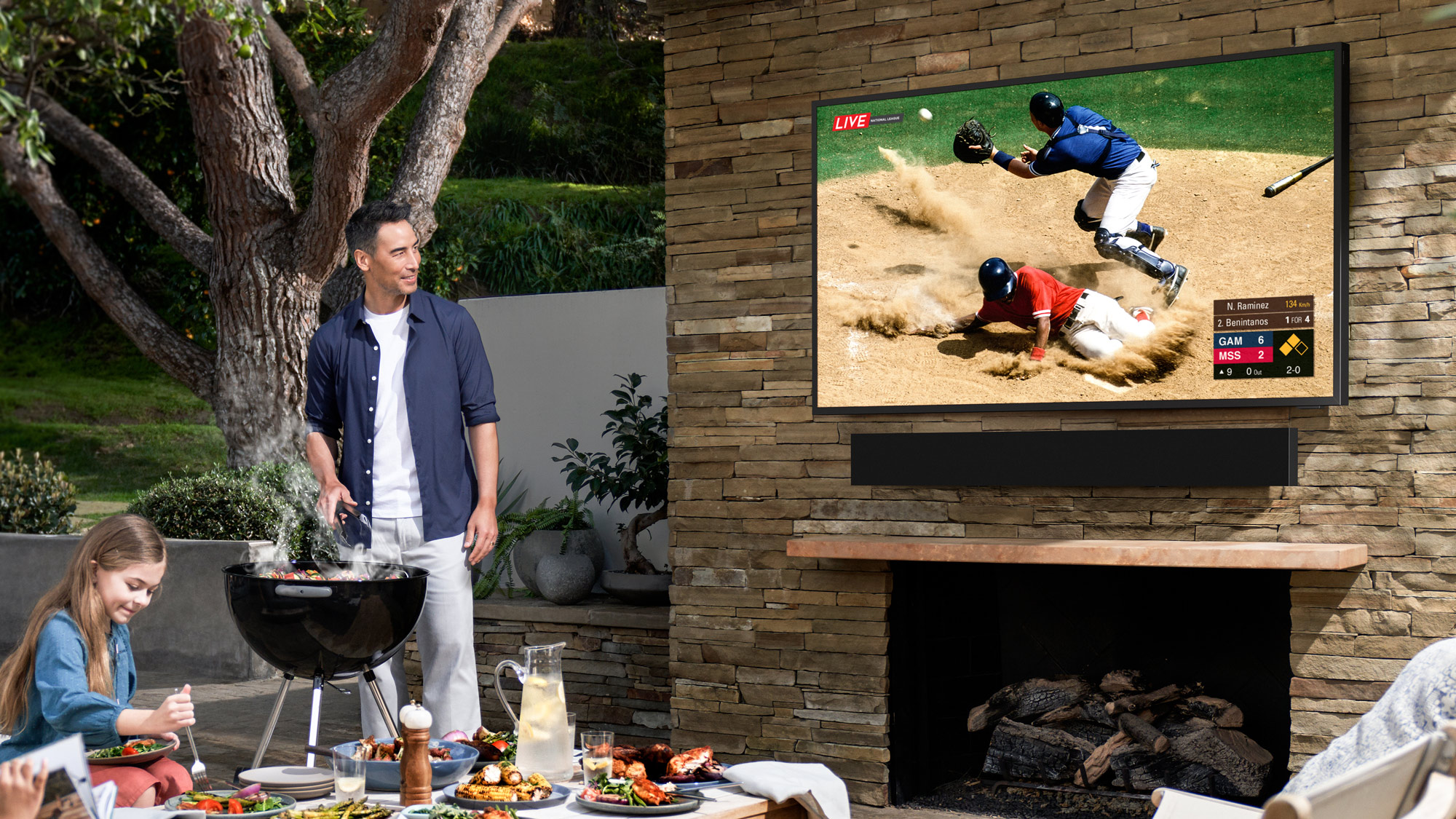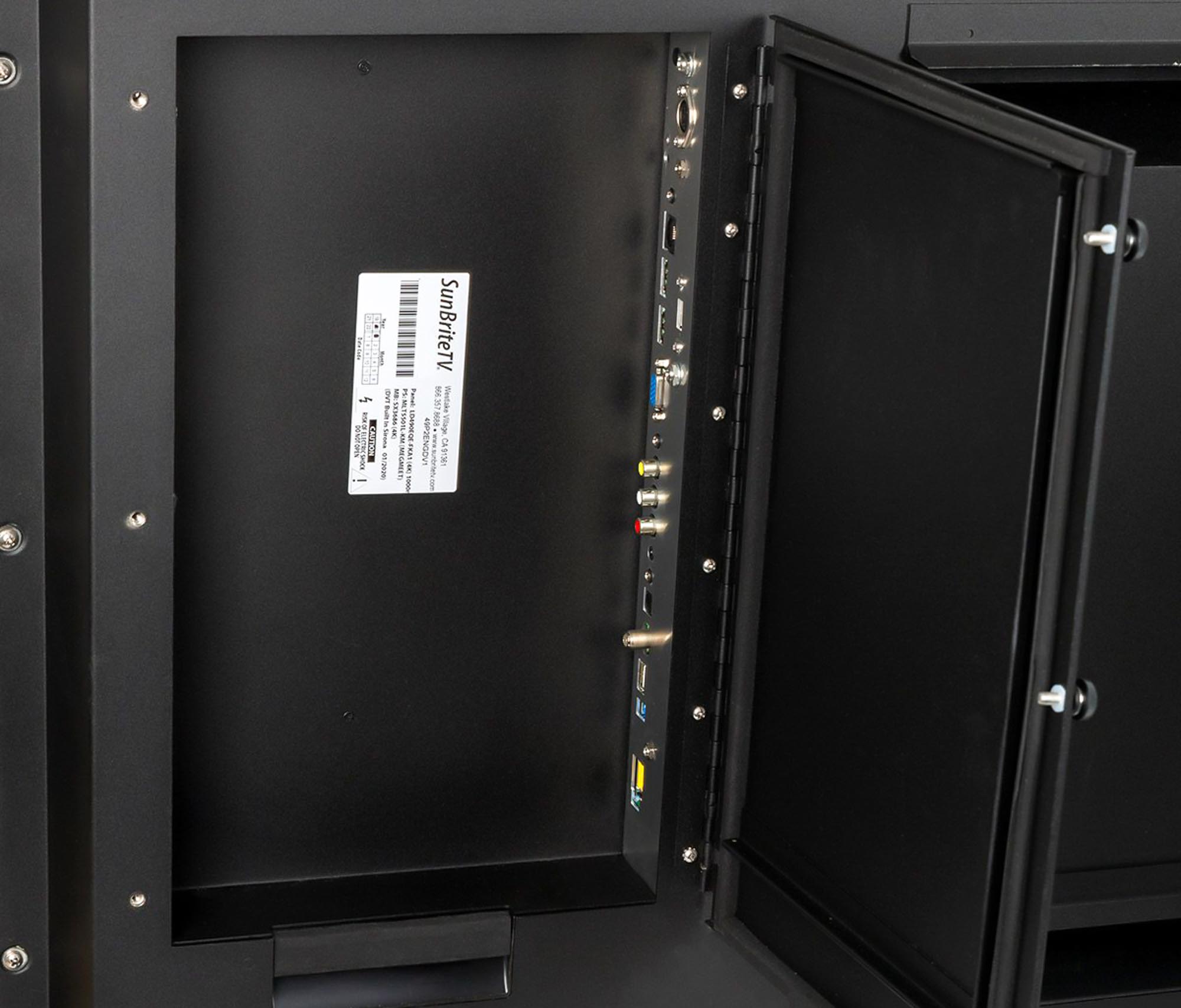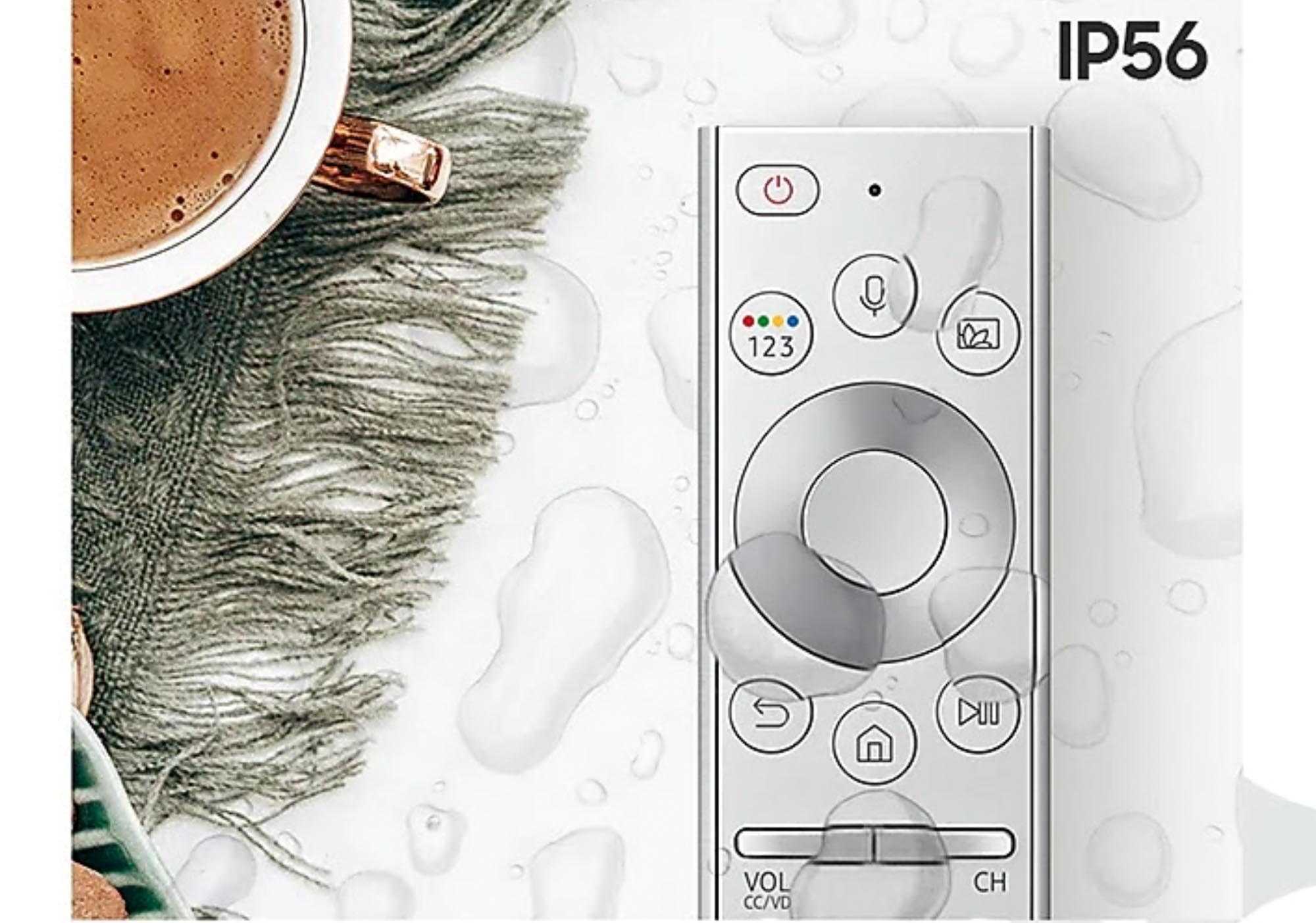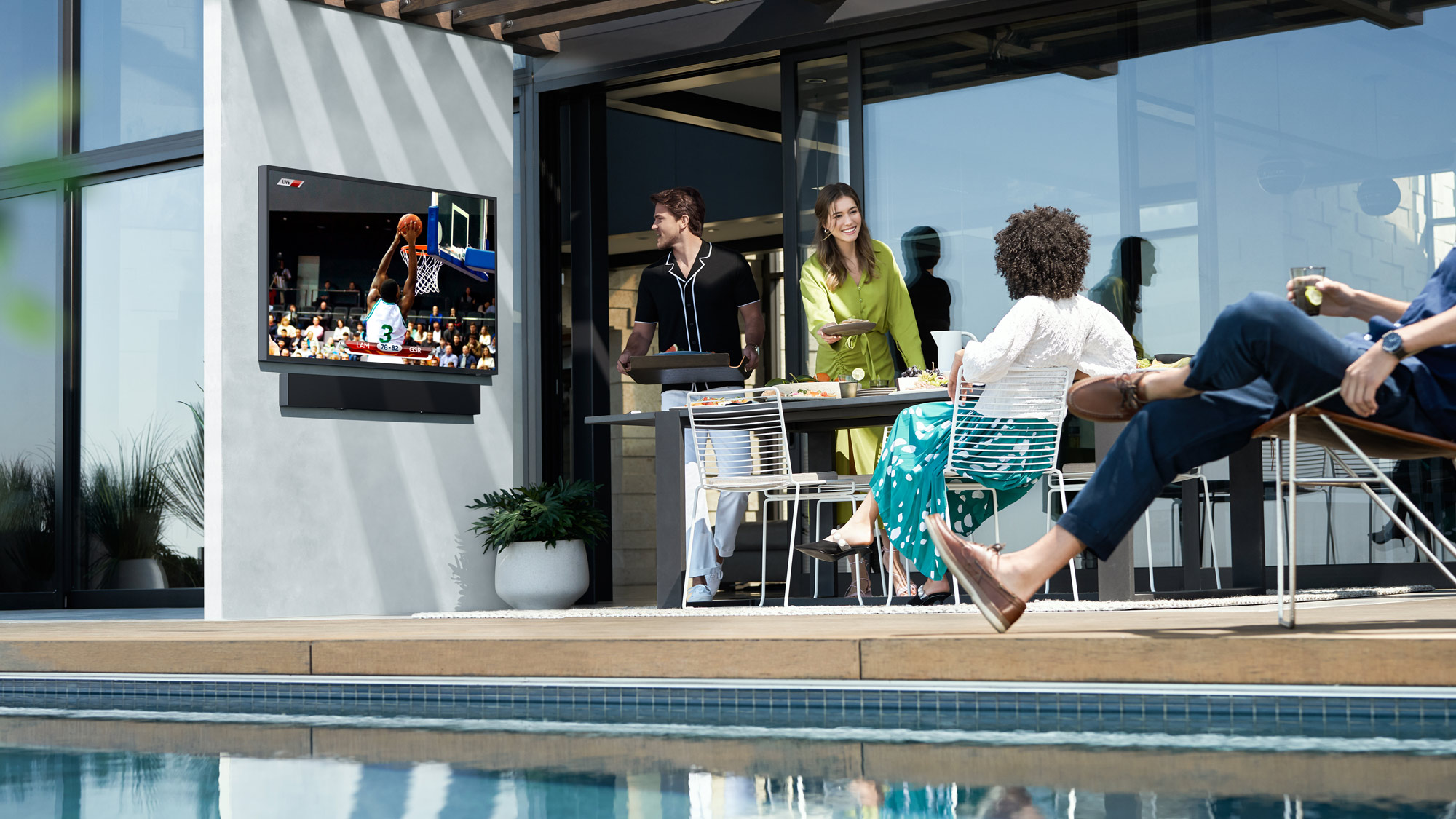How to buy the best outdoor TV
Everything you wanted to know about outdoor TVs, but were afraid to ask.

Thinking about buying an outdoor TV? Perhaps you were wowed by a fancy outdoor setup on Instagram or a high-end house renovation on HGTV. Maybe you've dreamed of barbecuing during the big game, or watching movies while you soak in a hot tub. Whatever the motivation, getting a TV setup outside isn't as simple as dragging your favorite OLED out into the backyard.
If you've looked at past reviews for the SunBriteTV Veranda or the SunBriteTV Pro 2, you've probably wondered what the big deal was about these otherwise average looking TVs. In fact, outdoor TVs are a specialized category that sits separate from the vast majority of 4K TVs and smart TVs you'll find on our best TV list. With unique features, like weatherproofing and sunlight visibility, a good outdoor TV may cost a pretty penny, but it will be a worthwhile investment every time you enjoy a movie or show in the comfort of your backyard.
What is an outdoor TV?
Why you can trust Tom's Guide

Outdoor TVs are – surprise, surprise – TVs that are made for use outside. They're built to be viewable in sunshine, withstand the weather and survive all sorts of stuff that would render the average TV broken and useless.
Given that just taking a regular TV outside will void the warranty and risk exceeding the advised operating temperatures, you definitely want to get a TV that's built for the elements before you set up a movie night by the pool.
What makes an outdoor TV different?
So what makes an outdoor TV different? What gives them their weather-proof, temperature defying, bug-repelling superpowers? Well, just like a rugged phone or a ToughBook laptop, they're specially made to survive exactly the sort of things that are so bad for regular TVs.
Here's a quick list of design tweaks that any good outdoor TV will offer:
- Durable materials
- Sealed vents and speaker grilles
- Sealed seams, screw holes
- Weatherproofed port compartments
- Built-in temperature management
Indoor TVs use plastic construction, rely on passive airflow for cooling, and have zero protections against moisture, temperature changes or other hazards. In fact, just sitting in direct sunlight for a few minutes can take a regular TV beyond the safe operating temperature.

Outdoor TVs, on the other hand, use full-metal enclosures, rust-resistant powder coat paint, and impact resistant glass on the display. Active heating and cooling – literally, built-in cooling fans and even small heaters – are used to keep the internals cool in the summer and warm in the winter. And every seam, screw hole and gap on the TV exterior is either glued, caulked or fitted with gaskets and filters to keep unwanted material out.

Then there's the issue of sunlight. Outdoor TVs have to compete with the power of the sun, and they do this with a combination of anti-glare coatings, specialized filters, higher-than-average screen brightness and even automatic picture adjustments that adapt as the sun goes down.

And it's not just the TV that needs to be built for the weather. Remote controls have to also withstand water and dirt – the remote that comes with Samsung's Terrace TVs carries an IP56 rating!
Other accessories get the weatherproofing treatment, as well. Soundbars utilize woofers and tweeters that are resistant to temperature changes and sealed against moisture. TV mounts use anodized coatings and industrial-strength paint to prevent rust and corrosion.
The bottom line is that when it comes to TVs, anything that's going to be used outside needs to be purpose-built for outdoor use.
How much do outdoor TVs cost?
The most affordable outdoor TVs aren't too terribly expensive, ringing up at prices close to other premium 4K TVs, starting around $1,000. But they go up considerably as the quality and rugged features increase, with top models coming in at $3,000-5,000 or more. But that wide variety in pricing accommodates a wide variety, as different lighting and environmental conditions require different levels of protection and hardware optimization.
Two of our favorite TVs illustrate this difference clearly. The 55-inch SunBriteTV Veranda, designed for full-shade use, sells for a pretty reasonable $1,999. The 49-inch SunBriteTV Pro 2, on the other hand, is viewable in direct sunlight, and lists for $4,999.
What are outdoor TVs good for?
So why would you want an outdoor TV? Well, here are few scenarios:
If you have a nice outdoor patio setup, it can be a nice place to enjoy a family meal, or to sit and socialize with guests. But why end the pleasant outdoor evening to go inside and watch a movie? With an outdoor TV, you can bring movie night outside, so that you can still enjoy the perfect summer evening. Rain or shine, hot or cold, an outdoor TV can be left outside without worry about it being ruined by a chilly night or unexpected rain shower.

If you have a swimming pool or a hot tub, outdoor TVs make the perfect companion technology, letting you kick back and watch your favorite shows while you lounge in the pool. The waterproofing offered on outdoor TVs means you'll never have to worry about your pricey TV being destroyed by a simple splash of water.
If you need a TV for the garage or tool shed – a common haven for husbands and handy types – you can enjoy your favorite shows or even games without worrying that you'll lose your expensive TV to the cold or damp.
You get the idea. Anytime you've thought "wouldn't it be cool to have a TV out here?" you can now start thinking, "Hey, maybe I should put a TV out here."
Let's be honest, not everyone needs an outdoor TV. If you're happy to do your movie watching and gaming indoors, then you'll be just fine doing that. But if you want to enjoy a movie out in the backyard, or watch a show while you tinker out in the garage, an outdoor TV is probably what you need.
And one of the biggest customer groups for outdoor TVs aren't the usual TV watchers, or even home theater enthusiasts. It's commercial buyers, who use outdoor TVs in the outdoor seating of restaurants, by the swimming pool at hotels and other places where outdoor TV sets make sense.
Why are outdoor TVs so expensive?
Here's the thing. You should never try to use a regular TV outdoors. Not long term, not for a single afternoon. Just check your user manual – taking your TV outside is often enough to void your warranty. And anybody telling you otherwise should foot the bill when you accidentally ruin a $2,000 TV. Indoor TVs simply aren't made for outdoor use.
For one thing, they're nearly unusable. Sunlight makes most displays unwatchable, washing out the colors and rendering key aspects of picture quality moot – like contrast and brightness.

Audio is almost as bad, since indoor TVs are designed to take advantage of walls and ceilings to reflect sound. Take away the walls, and that superb audio suddenly doesn't sound so great.
But more than that, the great outdoors has a whole lot of ways to destroy a TV. Weather can damage a TV in several ways – moisture on the internals will do that pretty quick, whether it's a stray drop from a sprinkler or condensation after a humid day. And if you're near the ocean, that salty air is even worse, causing nasty corrosion.
Temperature fluctuations add the possibility of turning that moisture into ice, and fitted parts can separate or warp from cold or heat. Being made for the dry, temperature controlled environs of your home, most TVs aren't made to withstand weather of any sort.
But there are other TV-killers out in your backyard. Like dust and debris. Or bugs.
Yeah, bugs. They're actually a pretty big problem for outdoor TV use, because the combination of dark, narrow TV chassis designs and the warmth generated by the electronics inside make unsealed TVs a prime spot for bugs to bed down and start building nests. And you really don't want to risk having a nest of silverfish or spiders or wasps inside your TV.
How to buy the best outdoor TV

We've tested and reviewed several outdoor TVs over the years, and buying one requires thinking about a few key factors. Some are common to all TVs, like picture quality and support for features like high dynamic range (HDR) content, but others are peculiar to outdoor models.
Before shopping for a TV you should also think about where the TV is going to be installed, what sort of sunlight exposure it has during different times of day, and how it will be mounted. Individual TVs may also require you to buy accessories like mounting gear and external speakers, so that should factor into your budgeting as you weigh your options.
Resolution: As with any other TV, you'll narrow down your options considerably by knowing what you want. We definitely recommend going with a 4K display, as 8K TVs aren't available in outdoor models yet, and Full HD sets just look disappointing compared to modern 4K TVs.
Size: You'll want to go big with your outdoor TV. All of our regular advice about optimal viewing distance and TV position still hold true with outdoor models, but you can expect to have narrower viewing angles and seating is more likely to be farther back than it would be in your living room.
Port selection: You'll also want to confirm that the TV has all of the connections you need, whether it's HDMI ports for media players and game consoles, or Wi-Fi or Ethernet for smart functions and streaming.
Here's where things differ a bit from indoor TVs – your home theater gear might not be anywhere near your TV, especially if it's not made for outdoor use. So you'll want to consider more involved AV setups. Thankfully, many outdoor TVs offer options like HDBaseT, which transmits ultra-high-definition video, audio and Ethernet in the TV's power cable, or 4K over Ethernet, which lets you send high-resolution signals over longer distances than standard HDMI cables can handle.
HDR support: One feature that's often missing from outdoor TVs is HDR support. The boosted brightness of the display and the varying light conditions of outdoor viewing aren't always conducive to HDR content, so some manufacturers opt to skip it entirely. Others offer HDR, and even automatic adjustment to accommodate lighting changes, but those features cost extra. We like HDR in normal TVs, but here, it might be more expensive than you want to deal with.
Smart features: Similarly, one thing that's a lot harder to find in an outdoor TV is smart functionality. The majority of outdoor TVs are so-called dumb TVs offering a display and audio, but none of the online capability or app support that most modern TVs come with. You can find a few smart outdoor TVs, but it may just be easier to pick up one of the best streaming devices to add the platform of your choice.

Sunlight or shade: As you look at outdoor models, you'll see that some are rated for full shade, others for partial sunlight, and a few rated for full sunlight visibility. Generally speaking, the more sunlight a TV is built to contend with, the more expensive the TV will be. But even without the question of cost, it's still worthwhile to know where your outdoor TV is going to be, and how much sunlight it will be exposed to.
Accessories: Many outdoor TVs skip otherwise basic features, like speakers, in order to reduce costs, but also to provide a better solution, like a waterproofed soundbar, which will provide substantially better audio quality than built-in speakers. Other accessories you should consider buying include weatherproofed mounting brackets and TV covers to protect the TV when it's not in use.
Installation: Finally, if there's ever an instance where professional installation is a good idea, it's an outdoor TV. The whole endeavor is more complicated than any normal TV setup, especially if you want to mount the TV near a pool or hottub, hang it above a fireplace or near a barbeque, install separate speakers or connect to distant AV equipment without running cables across your lawn.
All in all, it's worth remembering that an outdoor TV is built for a specific set of circumstances, and you want to find the model that best matches the specifics of your backyard, deck, pool cabana or other outdoor situation.
Where to buy an outdoor TV?

Unlike your usual Samsung or LG TVs found on our best TVs list, you won't be likely to find many outdoor TVs in the TV aisle of your local electronics retailer. Instead, you'll largely be limited to shopping online, or finding specialty retailers that focus on outdoor installations.
For online shoppers, you can find a good number of outdoor TVs through major retailers like Amazon and Best Buy. These include brands that we've reviewed, like SunBriteTV and Samsung, as well as those we haven't, like Peerless-AV and Furrion.
And if you want an even broader selection of outdoor models, you can shop the manufacturers directly, through their individual websites. Some of the most popular outdoor TV brands include Samsung, SunBriteTV, Peerless-AV, Furrion, Séura and SkyVue.
Get instant access to breaking news, the hottest reviews, great deals and helpful tips.
Brian Westover is currently Lead Analyst, PCs and Hardware at PCMag. Until recently, however, he was Senior Editor at Tom's Guide, where he led the site's TV coverage for several years, reviewing scores of sets and writing about everything from 8K to HDR to HDMI 2.1. He also put his computing knowledge to good use by reviewing many PCs and Mac devices, and also led our router and home networking coverage. Prior to joining Tom's Guide, he wrote for TopTenReviews and PCMag.

